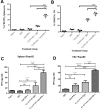PD-1/PD-L1 blockade together with vaccine therapy facilitates effector T-cell infiltration into pancreatic tumors
- PMID: 25415283
- PMCID: PMC4258151
- DOI: 10.1097/CJI.0000000000000062
PD-1/PD-L1 blockade together with vaccine therapy facilitates effector T-cell infiltration into pancreatic tumors
Abstract
Pancreatic ductal adenocarcinoma (PDA) has a poor prognosis due to late detection and resistance to conventional therapies. Published studies show that the PDA tumor microenvironment is predominantly infiltrated with immune suppressive cells and signals that if altered, would allow effective immunotherapy. However, single-agent checkpoint inhibitors including agents that alter immune suppressive signals in other human cancers such as cytotoxic T-lymphocyte antigen 4 (CTLA-4), programmed death 1 (PD-1), and its ligand PD-L1, have failed to demonstrate objective responses when given as single agents to PDA patients. We recently reported that inhibition of the CTLA-4 pathway when given together with a T cell inducing vaccine gives objective responses in metastatic PDA patients. In this study, we evaluated blockade of the PD-1/PD-L1 pathway. We found that PD-L1 is weakly expressed at a low frequency in untreated human and murine PDAs but treatment with a granulocyte macrophage colony-stimulating factor secreting PDA vaccine (GVAX) significantly upregulates PD-L1 membranous expression after treatment of tumor-bearing mice. In addition, combination therapy with vaccine and PD-1 antibody blockade improved murine survival compared with PD-1 antibody monotherapy or GVAX therapy alone. Furthermore, PD-1 blockade increased effector CD8 T lymphocytes and tumor-specific interferon-γ production of CD8 T cells in the tumor microenvironment. Immunosuppressive pathways, including regulatory T cells and CTLA-4 expression on T cells were overcome by the addition of vaccine and low-dose cyclophosphamide to PD-1 blockade. Collectively, our study supports combining PD-1 or PD-L1 antibody therapy with a T cell inducing agent for PDA treatment.
Figures





References
-
- Siegel R, Ma J, Zou Z, et al. Cancer Statistics, 2014. CA Cancer J Clin. 2014 - PubMed
-
- Moon HJ, An JY, Heo JS, et al. Predicting survival after surgical resection for pancreatic ductal adenocarcinoma. Pancreas. 2006;32:37–43. - PubMed
-
- Ma J, Siegel R, Jemal A. Pancreatic Cancer Death Rates by Race Among US Men and Women, 1970-2009. J Natl Cancer Inst. 2013;105:1694–700. - PubMed
Publication types
MeSH terms
Substances
Grants and funding
LinkOut - more resources
Full Text Sources
Other Literature Sources
Medical
Molecular Biology Databases
Research Materials

